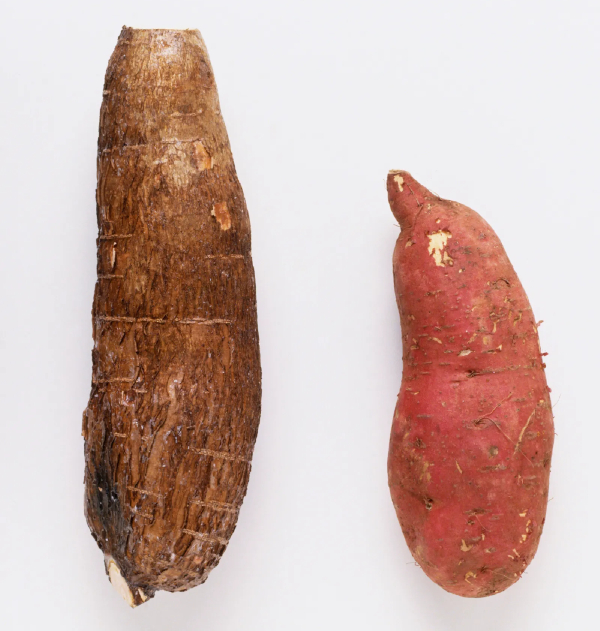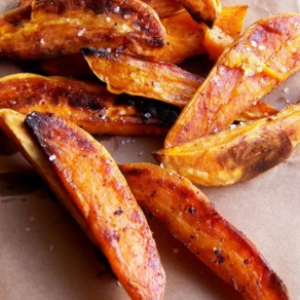The Sweet Potato is a southern staple. And it’s a holiday feat table tradition across North America. But most of us don’t really know what it is, or the bounty of nutritional goodness it offers. Sweet Potato is a superfood you don’t eat enough of!
 The yam (left) and the sweet potato (right). Definitely not the same veggie…
The yam (left) and the sweet potato (right). Definitely not the same veggie…
It’s the starch you thought you knew. But there’s a lot more to it than Sweet Potato Pie and Mash. And I’ll bet you had no idea what a rich and diverse source of essential nutrients it offers!
The clinical breakdown
A 100 g serving of Sweet Potatoes gives you alot! And what it doesn’t have is just as important as what it does have! You get no fat, no cholesterol, just 2 percent of your daily allowance of sodium, and a mere 6 percent of your daily allowance of carbs.
But on the plus side, you get 12 percent of your daily fiber. As for vitamins and minerals, that scoop of sweet potatoes provides significant amounts of: vitamins C, B5, B6 and E. Along with those, you get iron, manganese, copper and calcium.
If that wasn’t enough, Sweet Potato – a classic orange vegetable – packs a beta carotene punch, which is readily converted to vitamin A in the body. There is also lots of chlorogenic acid and anthocyanins – both of which are powerful anti-oxidants.
The benefits you can experience
- A boost to your overall nutrition profile
- Better gut health
- May fight cancer
- Promotes healthy vision
- May enhance brain function
- May support your immune system
Sweet Potatoes vs. Yams
First and foremost, yams are not the same as sweet potatoes. Sweet Potatoes are only distanmtly related to true potatoes. They’re both members of the nighshade family, but have evolved along different limbs of that genetic tree. And they’re both tubers that form on the roots of their namesake plants. And they’re native to the temperate zones.
Yams, on the other hand, are longer and larger than sweet potatoes, and are not related to them at all. And yams are native to Africa, and grow only in tropical climates.
Why the popular confusion?
According to bonappetit.com, “The prevailing theory is that enslaved Africans applied these terms over time to the sweet potatoes available in the Americas, which took the place in their diet of the staple root vegetable grown in much of West Africa.”
“Most of the so-called yams you see in American grocery stores are actually orange-fleshed sweet potatoes,” explains Mary-Frances Heck, a former BA staffer and the author of Sweet Potatoes. The reason for the name mix-up, she explains, is because Louisiana sweet potato growers in the 1930s marketed a new breed of orange-fleshed sweet potatoes as ‘yams’ to distinguish their crop from other states’ produce—and it stuck.
And, “To complicate things further, there are a handful of sweet potato varieties in a wide range of colors, including orange, white, and purple.”
How can you use them?
Sweet Potatoes are commonly used in festive pies, served mashed with butter, and baked with or without savoury stuffings. You can bake or roast them like a regular potato, or use them to make sweet potato ‘fries’. You can glaze them like your Grandma did carrots for festive feasts. You can use them in quick breads and conventional cakes just as you’d use bananas or zucchini.
Have you considered shredding them and frying up a batch of Hash Bowns? How about adding them as a super-tasty root veggie to soups and stews? Does the idea of a vegan pizza featuring sweet potato rounds instead of pepperoni appeal?
Try a bowl of sweet potato Hummus with your next round Middle Eastern meal. Or grilled sweet potato Baba Ganoush?
My take
The list of ways you can incorporate sweet potatoes in your daily meal plans is virtually endless. You can start with this idea-twigging website. And then go wild Googling ‘sweet potato recipes’ on the net. Make sweet potatoes the veggie you USED TO not eat enough of!
~ Maggie J.

